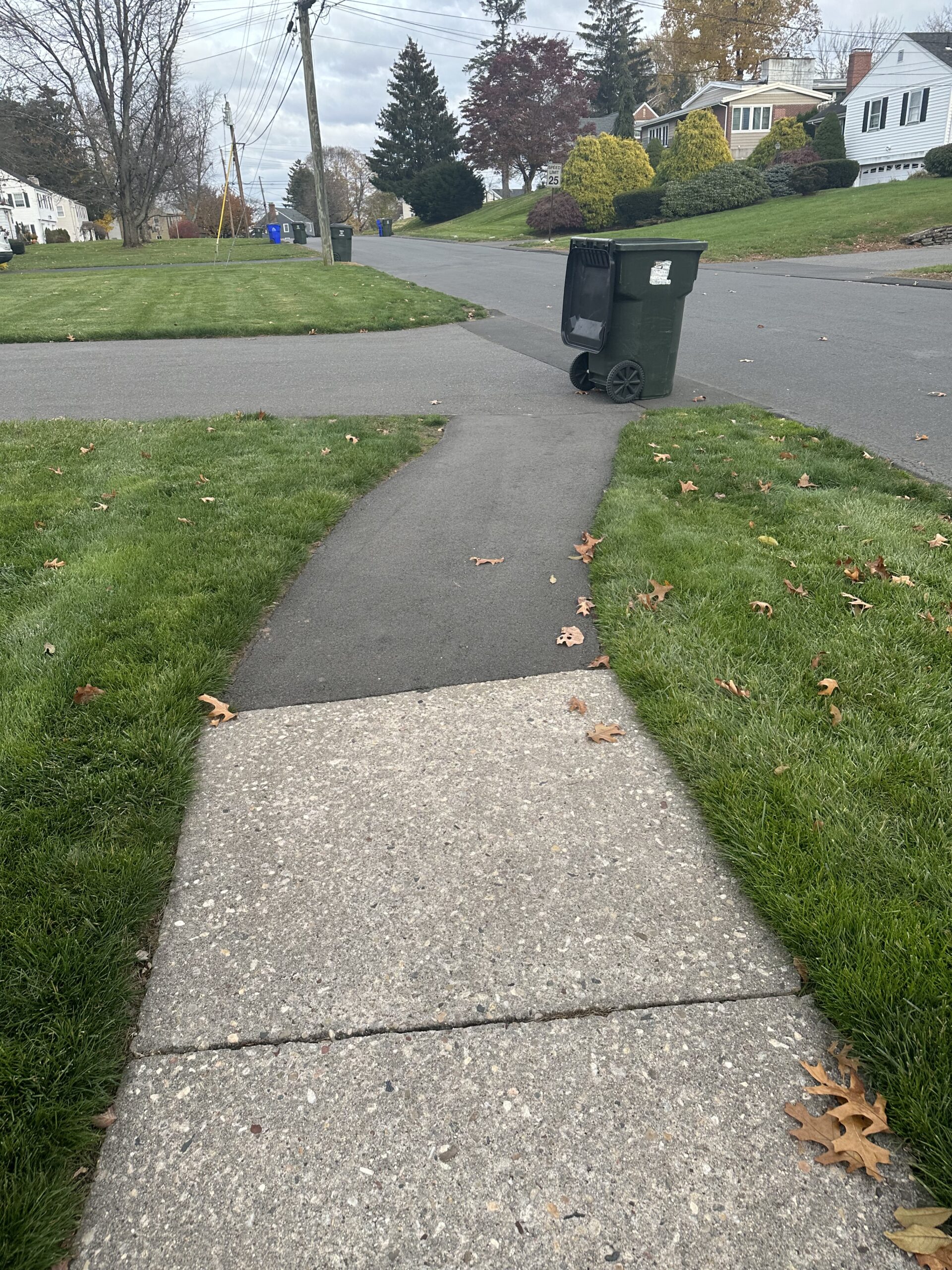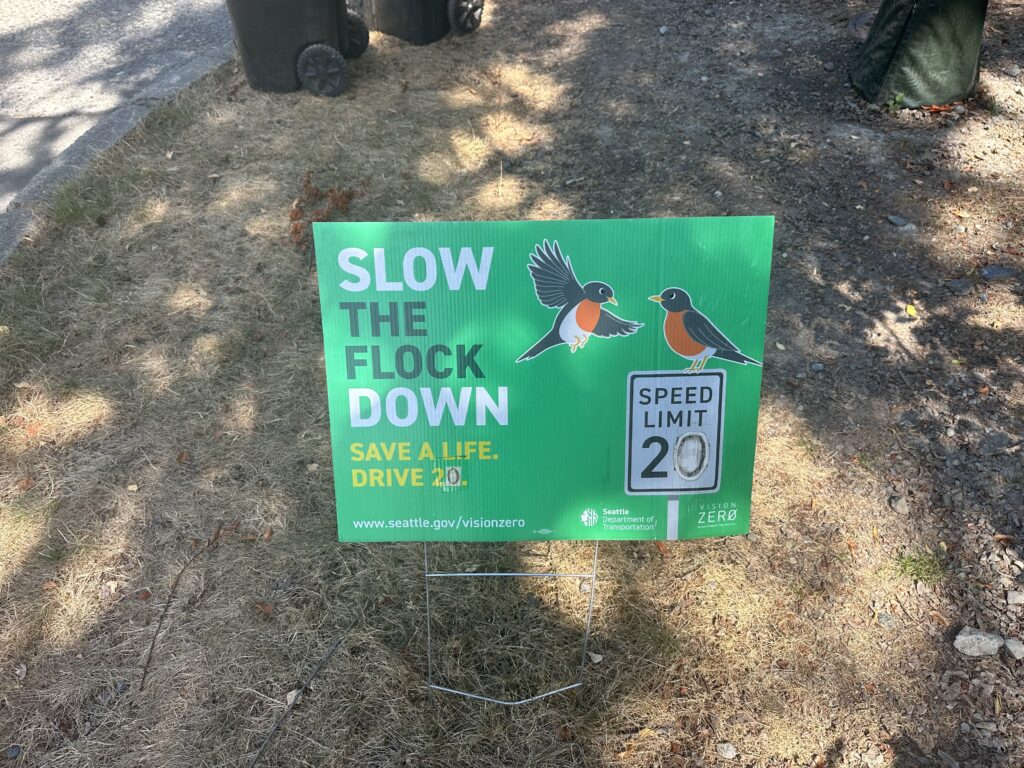Op-Ed: Walking in West Hartford

Audio By Carbonatix

Sidewalk abruptly ending on Overhill Drive. Courtesy photo
As part of an assignment for an English class at Hall High School, students were asked to write an essay about something that interests them. The following was submitted to We-Ha.com for publication by Hall High School junior Andrew Lurie.
By Andrew Lurie
I’ve lived in West Hartford for 12 years. For 10 of those years, I had never thought about the way we move around this town. In that sense, life was simple. My parents starting up an SUV, begging to ride shotgun, and rolling up to our destination with no trouble.
But as I aged, able to walk from school and to shops in Bishops Corner, I started to notice something: walking in West Hartford isn’t great.
It starts with the obvious – sidewalks are only sometimes present, and when they are, there is a severe lack of connection with other sidewalks. Even in school zones, where it seems we should allocate the most effort into providing high-quality sidewalk connections, the absence of these connections create a danger, especially for students.
Without connections, it is hard to choose walking over driving places – I only choose to walk when I have no other option.
Having good crosswalks is an integral part of having a walkable community. West Hartford does a good job of designing crosswalks through busy intersections, but for the most part, disregards less busy areas. Furthermore, there is a lack of non-intersectional crosswalks.
If you are walking from, say, Bishops Corner, to Asylum Avenue, the middle of your journey will contain zero crosswalks. The effect of this bad infrastructure means that walking in West Hartford feels dangerous – like the roads are sending a message that roads aren’t designed for you, but rather for high-speed motor vehicle traffic.
So how is West Hartford planning to address these problems? Well, the Vision Zero Task Force Action Plan has already gotten underway with it recently having its second public meeting. The plan itself covers a variety of topics – ranging from slowing down roads, increasing bicycle facilities, and even a variety of equity considerations. In terms of improvements to walking, establishing pedestrian zones and road calming techniques are great steps in the right direction. But perhaps more importantly, working to promote safe routes to school, and prioritizing school zones for better pedestrian infrastructure is crucial, as most students cannot rely on driving to get to school.
These propositions are great – they represent a positive shift in our town’s design. Yet while the plan seems to add further regulation for future design, it fails to address existing flaws in the town’s planning regulations. Through my own research, I discovered that West Hartford is unique in the sense that homeowners have a vast amount of power when it comes to the planning of the town.

‘Slow the Flock Down’ sign. Courtesy photo
While one might think that the town should have complete control over sidewalk locations and connections, it is actually the case that homeowners themselves have to vote to add a sidewalk to a neighborhood. If one appeals, the project will not come to fruition. The same is true for plowing snow – a homeowner is technically required to plow their sidewalk, but the town, as seen in the latest snow storm, does not enforce this rule. Town ordinances also limit crosswalks to specific areas, which is why you rarely see crosswalks crossing neighborhood streets even if said sidewalk route travels along a busy corridor. These critical flaws severely limit the town in pursuing improvements in connectivity in order to make our town less hazardous for those outside of a motor vehicle.
There is one fundamental flaw in our town’s design that trumps the previous gaps, however. If you were to look at a map of West Hartford, with the center at its core, you would see, although not perfect, a grid layout. Pan southward or northward, and you will see a stark shift in design – neat grids become swirls of streets accommodating low-density housing. This design, made popular after the automobile boom, directs cars off of neighborhood streets and onto arterial roads like Main Street, Trout Brook Drive, and Farmington Avenue.

Map of West Hartford. Google maps
This design has the advantage of quieter neighborhoods, with little through traffic on neighborhood streets. But from a walkability standpoint, this design is slow and dangerous. With this design, pedestrians are forced to walk indirect, slow routes which eventually result in ending up on an arterial road made for cars. Very walkable cities, like Seattle, use a grid system – efficient and safe for foot and cycling traffic due to the ability to choose a less busy road that ends up in the same location. On Seattle’s non-arterial streets, you will find road calming techniques like speed bumps and roundabouts, effectively incentivizing through traffic on arterial streets, and making neighborhoods quieter.

Roundabout on 28th Avenue East, Seattle. Courtesy image
We know West Hartford needs a change in design. The question is whether we will implement strong, critical action to reduce accidents and improve the lives of all residents.
We-Ha.com will accept Op-Ed submissions from members of the community. We reserve the right to edit all submitted content.
Like what you see here? Click here to subscribe to We-Ha’s newsletter so you’ll always be in the know about what’s happening in West Hartford! Click the blue button below to become a supporter of We-Ha.com and our efforts to continue producing quality journalism.




Great op-ed. Love to hear from a high schooler! It’s also worth noting that your generation is going to really be dealing with the fallout from rapid climate change more than anyone else. Gen-Z also unfortunately suffers from really high rates of anxiety, depression, and isolation. The other truly unfair thing is that in suburbia, teenagers are either forced to drive (with huge safety risk, as we all know), one parent needs to deprioritize their career to shuttle kids around, or the teen basically has no independence. I learned this the hard way moving to Avon midway through high school – I was trapped at home. Car dependence at the expense of all other forms of transportation is not sustainable for anyone, especially young people.
What a fine, thoughtful piece Mr. Lurie. You write clearly and support your points with evidence. As a retired college prof I would have been delighted to have you in any of my classes. Despite the challenges you identify, I do hope you decide to do a lot more walking and biking. If we senior citizens can navigate our way around, I ‘m sure you can too. But after spending almost 30 years crossing Asylum Avenue to get to work, I do appreciate your hesitancy to do so. I came home most days with the same line: “The cars would so rather speed up and mow me down than slow down and let me cross.” Very few seemed to know that there is a law to stop for pedestrians in crosswalks. All best to you for your high school and future college career. You will clearly soar!
Thank you for your perspective on this matter. I think that the physical infrastructure of the town has a feedback relationship to the social infrastructure that has arisen. If we can begin change attitudes that individuals have made around the public weal, we can make changes to make the town more inclusive and more capable of handling the changes that the future will bring with climate crisis.